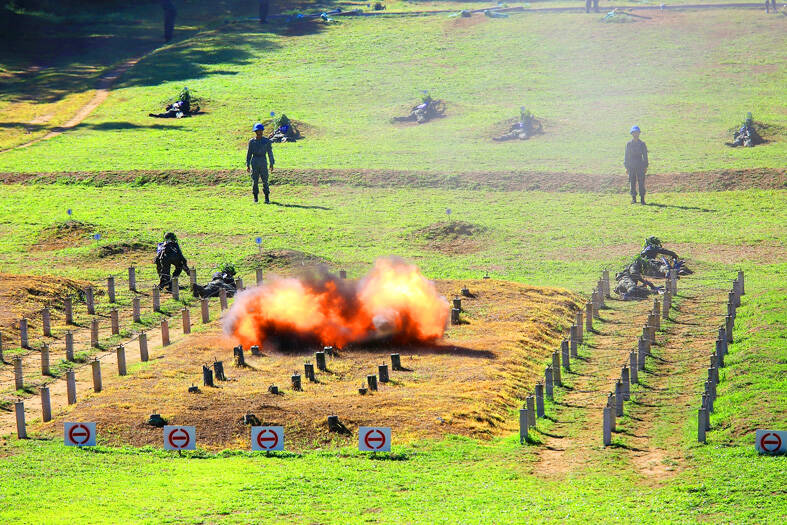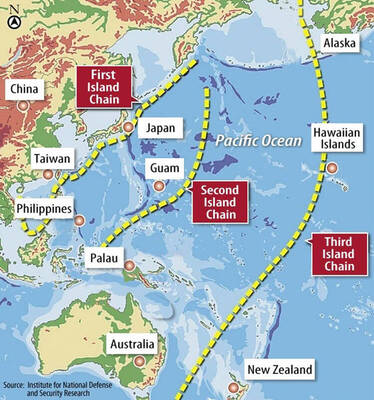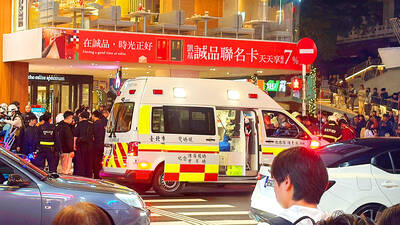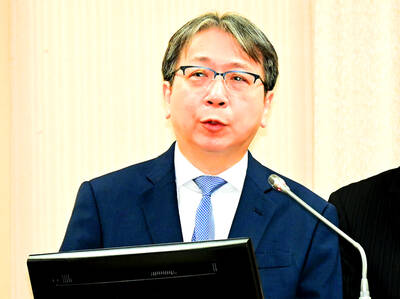The Chungshan Institute of Science and Technology has developed a polycyclic nitroamine explosive, commonly known as CL-20, which is the most powerful non-nuclear explosive known, a government source said yesterday on condition of anonymity.
The institute has significantly improved explosive and rocket propellant research and development in recent years, the source said.
A new factory was established in June 2022 with NT$540 million (US$16.6 million) in equipment installed, the source said.

Photo copied by Chen Wen-chan, Taipei Times
A central complex that would house 50-gallon (189 liters) and 300-gallon (1,136 liters) explosive mixer machines, as well as a storage device, was constructed in the factory, the institute said.
The explosive is 40 percent more powerful than those currently used and could be deployed for Hsiung Feng II (“Brave Wind” II, HF-II) and HF-III missiles, the source said.
The source did not comment on what other type of domestically manufactured missiles would be compatible with the CL-20 compound.
However, the institute has the intellectual property rights to all development and manufacturing of products using CL-20, and may authorize its use and production outside of the institute in favor of growing the national defense industry, the source added.
The US, the EU, China and Russia have also researched and made the compound, but due to its high-technical barrier and manufacturing costs, it has not entered commercial production, the source said.
Despite difficulties in mass production, CL-20 has seen some minor uses within the US and China, and has also been used in the Russia-Ukraine war, the source said.
The institute carries the heavy responsibility of researching and developing explosive compounds for the national defense sector, which has become even more important following the passage of the Sea-Air Combat Power Improvement Plan Purchase Special Regulation (海空戰力生計畫採購特別條例) and the increased production of missiles of all types, the source said.
The research and development of rocket propellants was a significant task, the institute said, adding that it was building a solid foundation for basic production capabilities.
To achieve this, the institute said it has ensured that the compound mixing and propellant research areas are safe, equipped with up-to-date machinery and technology, and are comfortable to work in.
In tandem with domestic companies, the institute has researched and built a 1,136-liter mixer from the ground up, further enhancing the autonomy of Taiwan’s national defense sector.

The US government has signed defense cooperation agreements with Japan and the Philippines to boost the deterrence capabilities of countries in the first island chain, a report by the National Security Bureau (NSB) showed. The main countries on the first island chain include the two nations and Taiwan. The bureau is to present the report at a meeting of the legislature’s Foreign Affairs and National Defense Committee tomorrow. The US military has deployed Typhon missile systems to Japan’s Yamaguchi Prefecture and Zambales province in the Philippines during their joint military exercises. It has also installed NMESIS anti-ship systems in Japan’s Okinawa

TRAGEDY STRIKES TAIPEI: The suspect died after falling off a building after he threw smoke grenades into Taipei Main Station and went on a killing spree in Zhongshan A 27-year-old suspect allegedly threw smoke grenades in Taipei Main Station and then proceeded to Zhongshan MRT Station in a random killing spree that resulted in the death of the suspect and two other civilians, and seven injured, including one in critical condition, as of press time last night. The suspect, identified as a man surnamed Chang Wen (張文), allegedly began the attack at Taipei Main Station, the Taipei Fire Department said, adding that it received a report at 5:24pm that smoke grenades had been thrown in the station. One man in his 50s was rushed to hospital after a cardiac arrest

PUBLIC SAFETY: The premier said that security would be tightened in transport hubs, while President Lai commended the public for their bravery The government is to deploy more police, including rapid response units, in crowded public areas to ensure a swift response to any threats, President William Lai (賴清德) said yesterday after a knife attack killed three people and injured 11 in Taipei the previous day. Lai made the remarks following a briefing by the National Police Agency on the progress of the investigation, saying that the attack underscored the importance of cooperation in public security between the central and local governments. The attack unfolded in the early evening on Friday around Taipei Main Station’s M7 exit and later near the Taipei MRT’s Zhongshan

ON ALERT: Taiwan’s partners would issue warnings if China attempted to use Interpol to target Taiwanese, and the global body has mechanisms to prevent it, an official said China has stationed two to four people specializing in Taiwan affairs at its embassies in several democratic countries to monitor and harass Taiwanese, actions that the host nations would not tolerate, National Security Bureau (NSB) Director-General Tsai Ming-yen (蔡明彥) said yesterday. Tsai made the comments at a meeting of the legislature’s Foreign Affairs and National Defense Committee, which asked him and Minister of National Defense Wellington Koo (顧立雄) to report on potential conflicts in the Taiwan Strait and military preparedness. Democratic Progressive Party (DPP) Legislator Michelle Lin (林楚茵) expressed concern that Beijing has posted personnel from China’s Taiwan Affairs Office to its